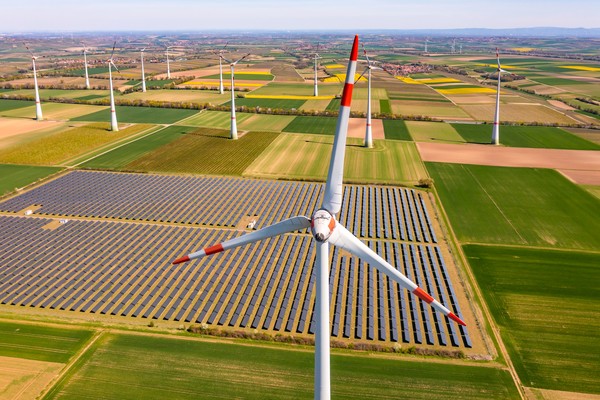
The Industrial and employment advantages of the energy transition
In order to achieve the objectives of the Green Deal, EUR 320 billion in Italy per year will be needed until 2030. But investments in renewables are not just a cost item, they also have important economic implications with an overall added value that will reach EUR 360 billion in 2030
The energy transition represents one of the most significant challenges of our time, and is also a strategic opportunity to promote industrial development, employment growth and environmental sustainability”.
Thus begins the report on the topic “Industrial and employment advantages generated by RES”, (Renewable Sources and Energy Efficiency) produced by the Coordinamento
FREE Association. The document was created by a specific working group established within the Coordinamento FREE Association which represents the main green energy technologies and supply chains in Italy. For bioenergy, the contribution was provided by ITABIA which highlighted the centrality of modern mechanization for the
supply of biomass. The report signed by the Coordinamento FREE Association is extremely important because it stimulates serious reflection on the economic advantages that come from renewables and describes all the valid motivations
that are at the basis of the huge investments in decarbonization.
According to the latest World Energy Investment document from the IEA, in 2024, global investstanments in clean energy (renewables, electric vehicles, nuclear, smart grids, storage, biofuels, etc.) amounted to almost USD 2 trillion and almost doubled compared to those allocated to fossil fuels such as coal, gas and oil (just over USD 1 trillion). As one can easily imagine, the spending capacity for energy transition is very limited in countries with emerging and developing economies, while China will predictably invest more in the coming years than the USA and
Europe combined.
Among all electrical renewables, photovoltaic is certainly the sector that holds the world record for investments, exceeding those of all other technologies put together. Last year, in fact, were spent on solar energy USD 500 billion
thanks to the impetus given by the significant drop in module prices, while in the sphere of energy efficiency the contribution made to technological modernization, distribution networks and storage systems has been even more significant,
having benefited by over USD 1.2 billion. At the global level, the resources needed for the aforementioned investments come mainly from the private sector, in particular from corporate actors (48%), meaning private companies.
These are followed by states and state-owned enterprises (37%), which play an important role in financially supporting the sector, especially with regard to strategic and public interest infrastructure projects. A smaller share of investments comes from private users (15%), mainly through the purchase of domestic energy devices such as solar panels, energy storage systems and electric vehicles.
This mix of private and public resources will be crucial in facilitating the path towards the energy transition thanks to more efficient and low-carbon systems.
To achieve the European Green Deal target, it is estimated that EUR 480 billion per year of additional investments will be needed until 2030. The US is no exception, as the previous Biden administration allocated around USD 700 billion a year to energy transition subsidies through the Inflation Reduction Act (IRA). On this front, therefore, Europe must provide adequate responses so as not to end up in
marginal positions.
In this framework, certainly made less linear by the complex geopolitical scenario, the transition towards renewables, which would also provide a significant amount of energy autonomy to Italy, takes on an increasingly strategic role. It is well known that international crises have exacerbated the costs of energy and raw materials. In Italy, for example, the price of gas has increased almost six times compared to the average of recent years, going from around EUR 20/MWh between October 2018 and September 2019, to over EUR 120/MWh in the period October 2021 - September 2022. The price of electricity also increased fivefold between 2018 (PUN (National Single Price) at EUR 61/MWh) and 2022 (PUN (National Single Price) at EUR 303/MWh). To date, in Italy, the electrical component accounts for approximately 23% of final energy consumption at the national level, while oil and natural gas together account for approximately two-thirds of consumption. On the
other hand, the electricity generation mix is still unequally balanced towards fossil fuels, which cover approximately 70% of national production with just under 170 TWh (2023) out of a total of 257 TWh.
The greatest electrification potential is estimated to be in the transport and residential sectors, with a possible increase from 3% to 41% and from 15% to 53%, respectively, over the period from 2015 to 2050. Further increases are, however, also possible on the industrial front (currently at 39%), reaching an estimated 42% in 2050.
Considering the scenarios in play, it is plausible that over the next few years in Italy electricity consumption will increase due to growing demand for electrification in the various economic sectors (residential, tertiary, industrial, and
transport). An industry study has estimated that electricity demand will reach 360 TWh in 2030, net of the growing share of efficiency in final consumption. According to the trajectories outlined by the Electricity Sector Plan within 5 years (2030) Italy aims to achieve 84% of renewable electricity share in the electricity mix, to save 20 billion m3 of imported natural gas, generate 85 GW of new RES power, and produce 80 GWh of new large-scale storage capacity.
With regards to environmental, economic and social advantages for Italy, the estimates for 2030 show: EUR 320 billion of cumulative investments by 2030 in the electricity sector and its industrial supply chain; EUR 360 billion of cumulative economic benefits by 2030 in terms of added value for the supply chain and related industries, and growth in national consumption; minus 270 million t CO2 equiv. emitted by the electricity sector in the 2030 Plan period; 540,000 new jobs in the electricity supply chain and related industries in 2030 (which will be added to the approximately 120,000 at present). With regard to the forecasts relating to employment induced by electric RES, the Report prepared by the experts of the Coordinamento FREE Association contains some realistic estimates made on 6
specific sectors (see text box), which differ slightly from the aforementioned Sector Plan, further confirming the development opportunities offered by green energy.
Employment growth in Italy in the next 3-5 years for some RES sectors
(Coordinamento FREE Association Report)
Photovoltaics: Italy employs 76,000 people, fourth in Europe after
Germany, Poland and Spain. Target 100,000 employed by 2028.
Wind: At present, the wind sector employs approximately 16,000
workers. There are 73,000 new jobs anticipated, divided into 1/3 direct
and 2/3 side-effect.
Heat pumps: There are already 139,000 plumbers working in the
sector today, but new skills are needed. Another 40,000 employees
are envisaged.
Biogas and Biomethane: the approximately 6,300 direct and indirect
sector jobs should see a further 8,000 come in with the
biomethane supply chain.
Biomass: the current 70,000 operators distributed across the entire
wood-energy supply chain could double by improving national forestry
supply chains.
Green hydrogen: Overall, the number of jobs in the hydrogen supply
chain is expected to grow by 300,000 by 2050.








